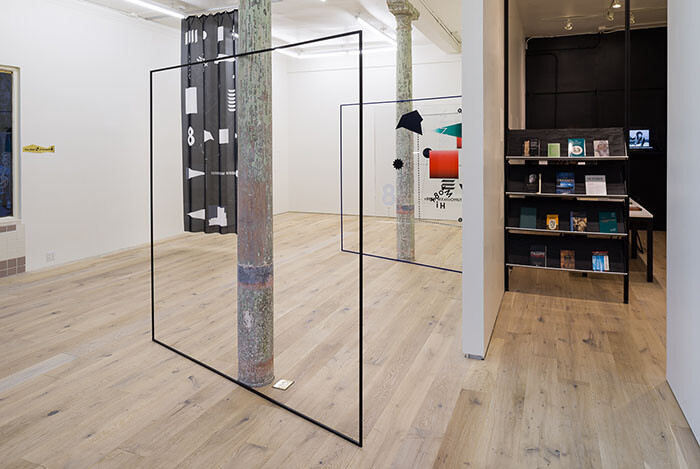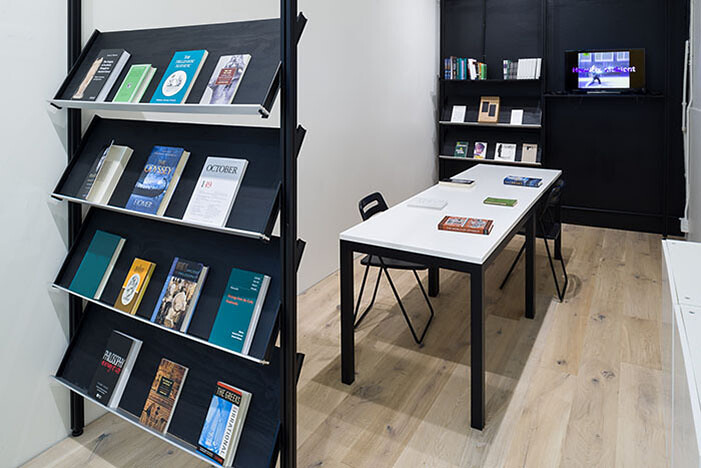Paul Chan is clearly energized by the Greek word polytropos. Homer used the word, translated as “cunning,” numerous times to describe Odysseus.1 This information, conveyed by Chan to a rapt audience during a two-part lecture, was included in the opening-week program for the new gallery Kiria Koula in San Francisco’s Mission District. The talk, Odysseus as Artist, drew parallels between the position of the Greek hero—stranded far from home and tempted by the seductions of material wealth—and that of contemporary artists, who must use their “cunning” to succeed in an increasingly market-driven global art world. This improbable but convincing metaphor is apt for Kiria Koula, a commercial gallery and bookstore committed to supporting new work and research in the spirit of a non-profit.
Along with Chan (who selected texts related to his research on The Odyssey for visitors to browse and potentially purchase), Mexican artist José León Cerrillo and Swedish artist Ilja Karilampi inaugurate the converted laundromat with visually disparate works connected by a focus on language and iconography. Cerrillo presents four glass panels containing geometric graphic symbols (all 2014)—what he dubs as “poems”—which are attached at right angles to a wall bifurcating the main gallery space. Three thin spray-painted iron frames set off from the translucent rectangles, Subtraction screen 5, 6, and 7, along with a hanging black curtain, UNTITLED, divide the space into sections, blurring the line between contemporary art and modernist décor. Placed throughout the gallery, Karilampi’s four engraved brass panels—SweSh iPhone; The Chief Dean of Gangsta Shape; Hotel Opalen, Hendrix 1968; and W€LL $PENT V.I.P. Taxi (all 2014)—also appear as functional as well as aesthetic. Viewed together, the works deploy a broad iconography to flout the traditional boundaries of visual art, and offer new modes of expression that rely on connections with broader culture rather than art historical knowledge.
Cryptic symbols on Cerrillo’s panels paired with his enigmatic titles imply a code to be cracked. POEM (theft and gift) includes a pink-to-black ombré rectangle, an irregular black heptagon, a spiked circle, and a white number eight, all linked via dotted lines. A jumble of seven letters and numbers sit in a pile in the bottom left quadrant. Abstract art, linguistic diagrams, and architectural renderings collide, begging interpretation yet remaining frustratingly impenetrable. Cerrillo appropriates visual elements from modern art, but he expands their potential meaning by opening up perception to include the viewer’s own base of knowledge and references. Combining graphic elements that evoke Russian Constructivism (and by extension its utopian underpinnings) with a quotidian decorative trope, Cerrillo slyly points to the increasing erosion of the barrier between the symbolic language of the erudite art world and the consumer marketplace for luxury goods.
Karilampi’s plaques are punctuations of pop culture that further remove art from a privileged context. Commissioned for the exhibition, each metallic sign operates as a title marker for four films—SweSh Xpress Geneve Trailer (2014), The Chief Architect of Gangsta Rap (2009), Hendrix Incident (2013), and W€LL $PENT: Mykki Blanco in Malmö (2012)—displayed on two monitors in the gallery, borrowing logos and textual styles from mass media and hip-hop. Graffiti scrawled across the exterior of the gallery windows (most likely by neighborhood kids staking out their turf) echoes the graphic style of the works that creates a subtle connection to the outside world. Etched on a nearby plaque, The Chief Dean of Gangsta Shape, are the words “The Chief of Gangsta” interrupted by two cartoonish graphics—a handshake between a black and a white hand and a playful smiling hand with fingers crossed, the logo for the British Commission for Racial Equality and the UK National Lottery respectively, a nod to the issues of race often entwined with rap music, and its favoring of symbols of material wealth.
The corresponding 11-minute video, The Chief Architect of Gangsta Rap, uses a BBC documentary style to interweave Karilampi’s autobiography with that of American rapper Dr. Dre and the architect Le Corbusier. Still photographs and the occasional video clip are accompanied by the artist’s lucid voiceover, which vacillates between English and Swedish, a further personalization of the narrative. While a video of his stepfather sorting records appears on screen, Karilampi admits to his own “insane attempts at creating associations,” a proclivity that resonates throughout the exhibition. Like Cerrillo’s works, Karilampi’s videos and plaques—with their music references and bling aesthetic—are boldly contemporary, but also engage with the recent past.
With Odysseus as Artist and its related texts, Chan revisits one of the oldest works of literature in the Western canon to dissect the state of contemporary art today, and Cerrillo and Karilampi share this impulse to incorporate outside disciplines and historical influences. By removing logos, symbols, and motifs from their original sources, the artists imply that visual iconography belongs to everyone, everywhere. Deciphering a perceived code becomes less important than acknowledging visual art’s entanglement with other forms of culture, manifested here in the artists’ own unexpected juxtapositions. By giving themselves license to interpret references for their own purposes, they give their viewers the freedom to do the same.
Chan chose to read Stephen Mitchell’s translation of The Odyssey (New York, Atria Books, 2013) because of his translation of the word “cunning” for polytropos. No consensus on the English equivalent exists, and other translators have used adjectives such as “resourceful,” “clever,” “much-traveled,” “wily,” and “versatile.”









